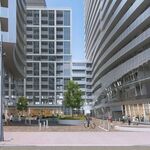It look like its for space. By scaling, I will assume that the cradle beam is 3m deep, and the needle beams 1m deep. The way they did it, the bottom of the needle beam is level with the underside of the Yonge Line station box. When the needle beam is inserted, its underside would 1m below the station box. As you can see towards the end, this stuff is left in place and becomes useless space - 1m of useless space.
Your suggestion would have the needle beam under the station box, and the cradle beam being below that. This would lead to 4m of useless space.
It looks like once the project is completed, all these beams are cast into a giant slab, so the connection of these beams is not a concern for the full 100+ design life. Despite this, enough bolts, and adequately tightened (see Nipigon River Bridge for what happens when they are not tightened properly, or properly designed), are not subjected to fatigue stresses so even long term performance is not a concern.
I doubt it governs, but supporting the load under the cradle beam is a bit more stable than having the load added to the top of the cradle beam. With vibration of the station, the needle beams could move laterally, potentially trying to tip over the cradle beams. This of course can be designed for, so it's not a huge deal.





